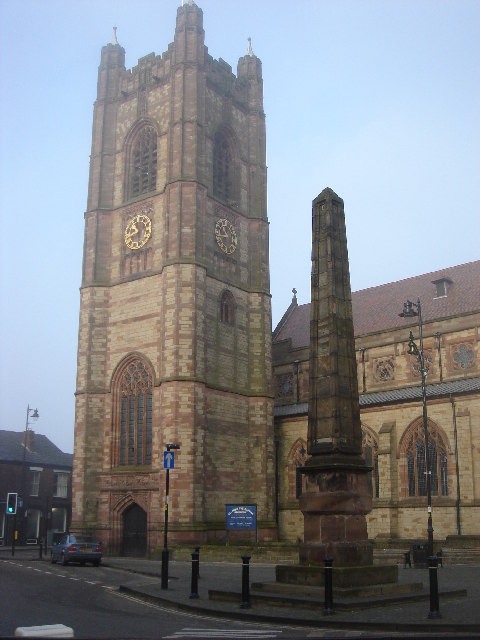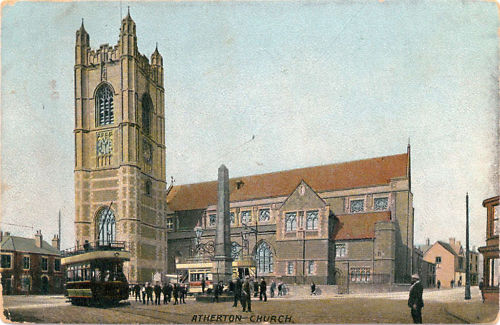St John the Baptist’s Church in Atherton, Greater Manchester is an active Anglican parish church in the Leigh deanery in the archdeaconry of Salford, and diocese of Manchester. Together with St George’s and St Philip’s Churches in Atherton and St Michael and All Angels at Howe BridgeSuburb of Atherton in Greater Manchester, built as a model mining village in the 1870s by the Fletchers., the church is part of the United BeneficeCollection of parishes working together under a single incumbent. of Atherton and Hindsford with Howe Bridge.[1][2][3] The church is recorded in the National Heritage List for England as a designated Grade II listed buildingStructure of particular architectural and/or historic interest deserving of special protection..[4]
Designed by Paley and Austin of Lancaster, the church was built in two phases and completed in 1896. It is considered to be one of their finest churches. It replaced the second Atherton Chapel and its predecessor the Old Bent Chapel that was built in 1645. Mining subsidence has caused its tower to lean.
History
St John the Baptist’s is built on the site of two older chapels. The first chapel was built in 1645 by John Atherton as a chapel of easeChurch subordinate to a parish church serving an area known as a chapelry, for the convenience of those parishioners who would find it difficult to attend services at the parish church. of Leigh Parish ChurchAncient parish church that served six townships.. It was sometimes referred to as the Old Bent Chapel.[5] It was not consecrated and used by Presbyterians as well as the Vicar of Leigh. In 1721, Richard Atherton expelled the dissenters who subsequently built Chowbent ChapelActive Unitarian place of worship in Atherton, Greater Manchester that was built in 1721. .[a]Chollebynt or Chowbent, shortened by locals to Bent, was the name given to the built-up part of Atherton from the mid-17th century for at least 300 years. The first chapel was consecrated in 1723 by the Bishop of Sodor and Man.[6]
A second chapel on the same site was consecrated by the Bishop of Chester in 1814.[6] It was in turn replaced by the present church, designed by the Lancaster architects Paley and Austin. The church was built in two phases. The chancelPart of a church containing the altar, used by the officiating clergy. and three bays of the nave were built in 1878–79,[7] and consecrated in 1879.[6] The cost was £10,000, of which £3,200 was given by the colliery owners Fletcher, Burrows and CompanyOwner of collieries and cotton mills in Atherton in North West England..[8] The west end, which included a modified version of the southwest tower 120 feet (37 m) high, was completed between 1890 and 1896 by the successors in the Lancaster practice, Paley, Austin and Paley.[9]
From 1899 the church was affected by mining subsidence, causing the tower to separate from the south aisle. The tower was stabilised, but remains out of alignment and is leaning. In 1991 the east end of the church was badly damaged by fire. It was repaired and re-ordered by Peter Skinner in 1996–97;[10] the re-ordering included dividing the chancel from the rest of the church to create a church hall.[10][11]
St John the Baptist has two daughter churches, St Michael and All Angels at Howe Bridge in 1878 and St Anne’s in Hindsford of 1901, both were designed by Paley and Austin.[12]
Structure
The church is constructed in Runcorn sandstone with ashlarMasonry of squared and finely cut or worked stone, commonly used for the facing of a building. dressings and a tiled roof.[13] Its architectural style is that of the late-Decorated period. Its plan consists of a five-bay naveCentral part of a church, used by the laiety. with a clerestory, north and south aisles, a two-bay chancel with a north chapel and a south two-storey vestry and organ chamber, and a southwest tower. The tower is in five stages with octagonal buttresses at each corner rising above the parapet to form turrets with conical caps. The parapet is embattled.[10] The doorway is on the south side of the tower, and above it is a four-light window. There are clock faces in the fourth stage, and the bell openings in the top stage have four lights. Above each bell opening is a statue in a canopied niche. On the south side of the church the windows have four lights, while those on the north side have three lights.[4] Along the clerestory are square windows, two to a bay, which contain two different types of tracery.[10] To the east of the vestry and organ chamber is an octagonal turret.[4] The west and east windows are large, the west window having seven lights, and the east window six.[10] Under the east window is red and buff chequerwork carved with roses, the IHC christogram, leaves and swords.[14] The hour-chiming clock was installed by Potts of LeedsCompany founded in 1833 in Leeds, England to make domestic timepieces , which expanded into the manufacture and repair of public clocks. in 1895.[15]
The interior is in Stourton stone with a Yorkshire stone floor.[13] The nave has a hammerbeam roofStructural framework of timbers designed to bridge the space above a room and to provide support for a roof. and the arcades are carried on clustered piers. The intricately carved chancel screen is now used as a reredosLarge ornamented wall, screen, or other structure placed behind the altar in a Christian church. behind the altar at the east end of the nave. The stone pulpit, which contains marble panels with niches depicting scenes from the life of Christ in semi-relief, is a memorial to the Rt Revd James Fraser, Bishop of Manchester, who died in 1885. The octagonal alabaster font is decorated with panels. Box pews, one dated 1728, have been re-used as dado panelling in the vestry. In the nave are lamps designed by Peter Skinner. The stained glass in the east window, dated 1896, is by C. E. Kempe, and a window in the south aisle contains glass by Ward and Hughes from 1895. In another south aisle window is glass from 1922 by Edward Moore, which has been moved from the north chapel. The rest of the windows were re-glazed with clear glass after the 1991 fire.[10] The two-manual pipe organ was built in 1967 by Hill, Norman and Beard,[16]to replace an earlier three-manual organ by J. C. Bishop and Son from 1888.[17]
Appraisal
The church was designated as a Grade II listed building on 15 July 1966. The National Heritage List for England describes it as “an imposing building which exhibits fine craftsmanship both inside and out”.[4] The authors of the Buildings of England series describe the church as “monumental, one of Paley & Austin’s best”, and that the tower is “magnificently monumental”.[10] Brandwood et al. in their book on the architectural practice of Sharpe, Paley and Austin agree that it is “one of Paley & Austin’s finest churches”.[14]
Notes
| a | Chollebynt or Chowbent, shortened by locals to Bent, was the name given to the built-up part of Atherton from the mid-17th century for at least 300 years. |
|---|




